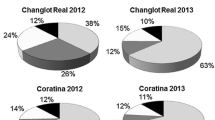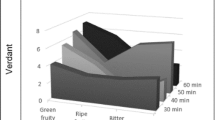Abstract
Extra-virgin olive oils used in the production of flavoured oils can derive from a single cultivar or can be a blend of two or more mono-varietal oils. In order to investigate the effects of the characteristics of the oil blends on the quality of the deriving flavoured oils, three mono-cultivar extra-virgin olive oils (Coratina, Peranzana, Ogliarola) were used to produce three blends, which were successively flavoured by infusion. From each blend, three types of flavoured olive oils were produced: basil, chilli pepper, and garlic + chilli pepper. Mono-varietal extra-virgin olive oils, blends, and flavoured oils were submitted for routine analyses and for determination of polar compounds, phenolic profile, antioxidant activity, and volatile profiles. The panel and consumer tests were also carried out on the flavoured oils. Along with the undoubted influence of the flavouring agents, the quality parameters of each blend changed and their changes greatly depend on the starting blend. The parameters mostly affected by oil blend were: acidity, K232, peroxide values, diacylglycerols, polar compounds, total phenolics, antioxidant activity, and phenolics such as p-coumaric acid, tyrosol acetate, vanillic acid, tyrosol, hydroxytyrosol, hydroxytyrosol acetate, dialdehydic form of elenolic acid linked to tyrosol, and ligstroside aglycone, oleuropein aglycone. The effects of oil blending were rather limited on volatile profiles and sensory characteristics.



Similar content being viewed by others
References
Caporaso N, Padano A, Nicoletti G, Sacchi R (2013) Capsaicinoids, antioxidant activity, and volatile compounds in olive oil flavoured with dried chilli pepper (Capsicum annuum). Eur J Lipid Sci Technol 115:1434–1442
Damechki M, Sotiropoulou S, Tsimidou M (2001) Antioxidant and pro-oxidant factors in oregano and rosemary gourmet olive oils. Grasas Aceites 52:207–213
Riva M, Di Cesare LF, Schiraldi A (1993) Microwave and traditional technology to prepare garlic aromatized olive oil. In: Charalambous G (ed) Food flavours, ingredients and composition. Elsevier, Holland
Baiano A, Gambacorta G, La Notte E (2010) Aromatization of olive oil. In: Pandalai SG (ed), Research Signpost, Kerala, p 1–29
Antoun N, Tsimidou M (1997) Gourmet olive oils: stability and consumer acceptability studies. Food Res Int 2:131–136
Gambacorta G, Faccia M, Pati S, Lamacchia C, Baiano A, La Notte E (2007) Changes in the chemical and sensorial profile of extra virgin olive oils flavoured with herbs and spices during storage. J Lipids 14:201–215
Tura D, Failla O, Bassi D, Pedò S, Serralocco A (2008) Cultivar influence on virgin olive (Olea europea L.) oil flavor based on aromatic compounds and sensorial profile. Sci Hort 118:139–148
Baiano A, Terracone C, Viggiani I, Del Nobile MA (2013) Effects of cultivars and location on quality indices, phenolic content and antioxidant activity of extra-virgin olive oils. J Am Oil Chem Soc 90:103–111
Predieri S, Medoro C, Magli M, Gatti E, Rotondi A (2013) Virgin olive oil sensory properties: comparing trained panel evaluation and consumer preferences. Food Res Int 54:2091–2094
EEC Regulation 2568/91 (1991) On the characteristics of olive oil and olive-residue oil and on the relevant methods of analysis. J Eur Union L 248:1
Baiano A, Gambacorta G, Terracone C, Previtali MA, Lamacchia C, La Notte E (2009) Changes in phenolic content and antioxidant activity of Italian extra-virgin olive oils during storage. J Food Sci 74:177–183
Di Stefano R, Cravero MC, Gentilini N (1989) Metodi per lo studio dei polifenoli nei vini. L’Enotecnico 5:83–89
Gambacorta G, Previtali MA, Pati S, Baiano A, La Notte E (2006) Characterization of the phenolic profiles of some monovarietal extravirgin olive oils of Southern Italy. In: XXIII International conference on polyphenols. Winnipeg 22–25 Aug 2006
AOAC (2003) In W. Horwitz (ed), Official methods of analysis of association of official analytical chemists international (17th ed). AOAC Press, Arlington
Gomes T (1992) Oligopolymer, diglyceride and oxidized triglyceride content as measure of olive oil quality. J Am Oil Chem Soc 69:1219–1223
Gomes T, Caponio F (1999) Effort to improve the quantitative determination of oxidation and hydrolysis compound classes in edible vegetable oils. J Chrom A 844:77–86
EC Regulation 640/2008 (2008) Amending regulation (EEC) No 2568/91 on the characteristics of olive oil and olive-residue oil and on the relevant methods of analysis. OJEU L 17:11–16
EU Regulation 61/2011. Amending regulation (EEC) No 2568/91 on the characteristics of olive oil and olive-residue oil and on the relevant methods of analysis. OJEU L 23:1–14
Angerosa F, Servili M, Selvaggini R, Taticchi R, Esposto S, Montedoro G (2004) Volatile compounds in virgin olive oil: occurrence and their relationship with the quality. J Chrom A 1054:17–31
Bayram B, Esatbeyoglu T, Schulze N, Ozcelik B, Frank J, Rimbach G (2012) Comprehensive analysis of polyphenols in 55 extra virgin olive oils by HPLC-ECD and their correlation with antioxidant activities. Plant Foods Hum Nutr 67:326–336
Bilancia MT, Caponio F, Sikorska E, Pasqualone A, Summo C (2007) Correlation of triacylglycerol oligopolymers and oxidised triacylglycerols to quality parameters in extra virgin olive oil during storage. Food Res Int 40:855–861
Materska M, Perucka I (2005) Antioxidant activity of the main phenolic compounds isolated from hot pepper fruit (Capsicum annuum L.). J Agr Food Chem 53:1750–1756
Lercker G (2004) Aspetti tecnologici e caratteristiche degli oli di oliva, Atti della “Giornata in commemorazione del Prof. Lotti”, Pisa 75–99
Caponio F, Gomes T, Pasqualone A (2003) Use of innovative analytical methodologies to better assess the quality of edible vegetable fats and oils. Pol J Food Nutr Sci 12(53):20–24
Bilancia MT, Caponio F, Sikorska E, Pasqualone A, Summo C (2007) Correlation of triacylglycerol oligopolymers and oxidised triacylglycerols to quality parameters in extra virgin olive oil during storage. Food Res Int 40:855–861
Gomes T (1992) Oligopolymer, diglyceride and oxidized triglyceride contents as measures of olive oil quality. J Am Oil Chem Soc 69:1219–1223
del Monaco G, Officioso A, D’Angelo S, La Cara F, Ionata E, Marcolongo L, Squillaci G, Maurelli L, Morana A (2015) Characterization of extra virgin olive oils produced with typical italian varieties by their phenolic profile. Food Chem 184:220–228
Gouvinas I, Machado J, Gomes S, Lopes J, Martins-Lopes P, Barros AIRNA (2014) Phenolic composition and antioxidant activity of monovarietal and commercial Portuguese olive oils. J Am Oil Chem Soc 91:1197–1203
Baiano A, Terracone C, Gambacorta G, La Notte E (2009) Changes in quality indices, phenolic content and antioxidant activity of flavored olive oils during storage. J Am Oil Chem Soc 86:1083–1092
Caponio F, Squeo G, Monteleone JI, Paradiso VM, Pasqualone A, Summo C (2015) First and second centrifugation of olive paste: influence of talc addition on yield, chemical composition and volatile compounds of the oils. LWT-Food Sci Technol 64:439–445
Servili M, Selvaggini R, Taticchi A, Montedoro GF (2001) Headspace composition of virgin olive oil evaluated by solid phase microextraction: relationships with the oil sensory characteristics. In: Spanier AM, Shahidi F, Parliament TH, Mussinan C, Ho CT, Tratras Contis E (eds) Food flavors and chemistry: advances of the new millennium. The Royal Society of Chemistry, Cambridge
Salvadeo P, Boggia R, Evangelisti F, Zunin P (2007) Analysis of the volatile fraction of “Pesto Genovese” by headspace sorptive extraction (HSSE). Food Chem 105:1228–1235
Bubola KB, Koprivnjak O, Sladonja B (2012) Influence of filtration on volatile compounds and sensory profile of virgin olive oils. Food Chem 132:98–103
Acknowledgments
Research supported with the contribution of a project co-financed by EU “P.O. Puglia FESR 2007/2013, Asse I, Linea 1.2, Azione 1.2.4, Bando – Aiuti a sostegno dei partenariati regionali per l’innovazione. Investiamo nel vostro futuro”.
Author information
Authors and Affiliations
Corresponding author
Ethics declarations
Conflict of interest
The authors have no conflict of interest to declare.
Compliance with ethics requirements
This article does not contain any studies with human or animal subjects.
Rights and permissions
About this article
Cite this article
Baiano, A., Previtali, M.A., Viggiani, I. et al. As oil blending affects physical, chemical, and sensory characteristics of flavoured olive oils. Eur Food Res Technol 242, 1693–1708 (2016). https://doi.org/10.1007/s00217-016-2669-1
Received:
Revised:
Accepted:
Published:
Issue Date:
DOI: https://doi.org/10.1007/s00217-016-2669-1




